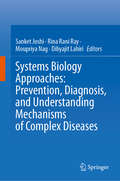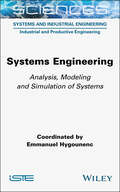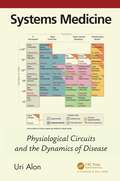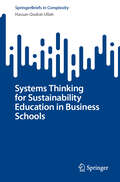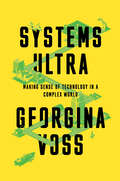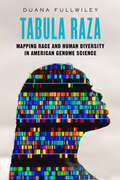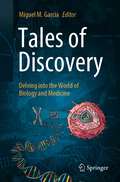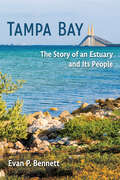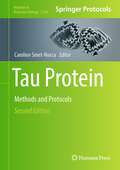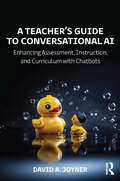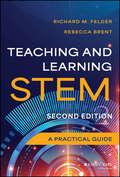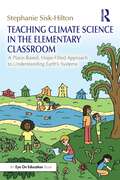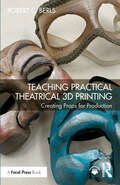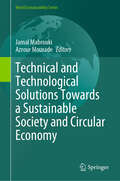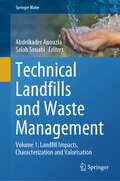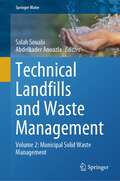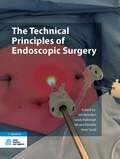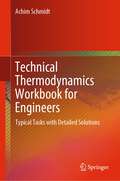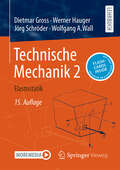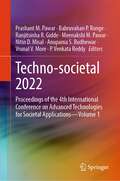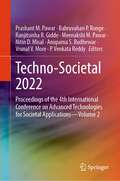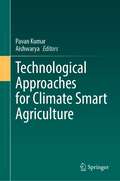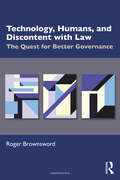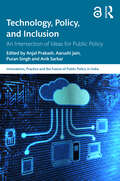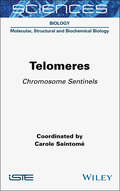- Table View
- List View
Systems Biology Approaches: Prevention, Diagnosis, and Understanding Mechanisms of Complex Diseases
by Sanket Joshi Rina Rani Ray Moupriya Nag Dibyajit LahiriThis book examines the development and applications of system biology approaches for the prevention, diagnosis, and understanding of disease mechanisms. It explores the applications of system biology in infectious diseases, including host-pathogen interaction, and the identification of targets for new therapeutics and intervention strategies. It covers the use of system biology for understanding and treating metabolic disorders towards personalized and precision medicine. The book further discusses the systems biology approaches for understanding the mechanisms of tumor progression and designing more effective cancer therapies. The chapter also reviews the current strategies in autoimmune disease treatment and highlights the opportunity that systems biology represents for the development of better and safer treatments. Importantly, the book discusses the current state of the systems-level understanding of diseases and both the therapeutic and adverse mechanisms of drug actions usingsystem biology approaches. Cutting across the disciplines, this book is a valuable source for researchers in genetics, molecular biology, cell biology, microbiology, and biomedical sciences.
Systems Engineering: Analysis, Modeling and Simulation of Systems
by Emmanuel HygounencThis book is intended for students, teachers, researchers, engineers and project managers wishing to understand and implement systems engineering into their work. Based on numerous bibliographical sources, it provides coherent and accessible information, complemented with numerous illustrations. Systems Engineering will enable the reader to not only understand but also master the development cycle of a system, as well as gain an in-depth understanding of the associated terminology. An introduction to systems theory is presented first, clarifying what is meant by a complex system. The book then outlines systems engineering and one of its components: requirements engineering. A detailed presentation of the downhill activities of the development cycle follows the definition of requirements and the design of systems. Finally, the book explores the upstream activities of the development cycle with the virtual and concrete integration of the system.
Systems Medicine: Physiological Circuits and the Dynamics of Disease (Chapman & Hall/CRC Computational Biology Series)
by Uri AlonWhy do we get certain diseases, whereas other diseases do not exist? In this book, Alon, one of the founders of systems biology, builds a foundation for systems medicine. Starting from basic laws, the book derives why physiological circuits are built the way they are. The circuits have fragilities that explain specific diseases and offer new strategies to treat them. By the end, the reader will be able to use simple and powerful mathematical models to describe physiological circuits. The book explores, in three parts, hormone circuits, immune circuits, and aging and age-related disease. It culminates in a periodic table of diseases. Alon writes in a style accessible to a broad range of readers - undergraduates, graduates, or researchers from computational or biological backgrounds. The level of math is friendly and the math can even be bypassed altogether. For instructors and readers who want to go deeper, the book includes dozens of exercises that have been rigorously tested in the classroom
Systems Thinking for Sustainability Education in Business Schools (SpringerBriefs in Complexity)
by Hassan Qudrat-UllahThis book delves into the current state and future prospects of systems thinking and sustainability education within business schools. It meticulously examines the trends and drivers shaping the demand and supply of such education, along with the implications and challenges it presents for various stakeholders and society at large. Strategic recommendations and suggestions are provided to elevate and propel systems thinking and sustainability education in business schools, outlining a visionary roadmap for the future. Furthermore, the book explores the intersectionality of sustainability and diversity in business education, offering examples and cases of visionary and innovative initiatives and projects in the field. Distinguished by special features such as illustrations, the book offers a comprehensive and integrative overview of the current landscape and future trajectories of systems thinking and sustainability education in business schools. The primary benefit for readers lies in gaining a deeper and broader understanding of systems thinking and sustainability education in business schools. It equips them with the knowledge to apply systems thinking and sustainability principles and tools to tackle the complex and wicked problems of the twenty-first century. Additionally, the book aims to inspire and inform business schools and their stakeholders to embrace and enhance systems thinking and sustainability education in their curricula and pedagogy, contributing to the advancement of sustainability and systems thinking in both business and society.
Systems Ultra: Making Sense of Technology in a Complex World
by Georgina VossA TOOLBOX FOR COMPREHENDING — AND CHANGING — THE WORLDSystems Ultra explores how we experience complex systems: the mesh of things, people, and ideas interacting to produce their own patterns and behaviours.What does it mean when a car which runs on code drives dangerously? What does massmarket graphics software tell us about the workplace politics of architects? And, in these human-made systems, which phenomena are designed, and which are emergent? In a world of networked technologies, global supply chains, and supranational regulations, there are growing calls for a new kind of literacy around systems and their ramifications. At the same time, we are often told these systems are impossible to fully comprehend and are far beyond our control.Drawing on field research and artistic practice around the industrial settings of ports, air traffic control, architectural software, payment platforms in adult entertainment, and car crash testing, Georgina Voss argues that complex systems can be approached as sites of revelation around scale, time, materiality, deviance, and breakages. With humour and guile, she tells the story of what &‘systems&’ have come to mean, how they have been sold to us, and the real-world consequences of the power that flows through them.Systems Ultra goes beyond narratives of technological exceptionalism to explore how we experience the complex systems which influence our lives, how to understand them more clearly, and, perhaps, how to change them.
Tabula Raza: Mapping Race and Human Diversity in American Genome Science (Atelier: Ethnographic Inquiry in the Twenty-First Century #14)
by Duana FullwileyDuana Fullwiley has penned an intimate chronicle of laboratory life in the genomic age. She presents many of the influential scientists at the forefront of genetics who have redefined how we practice medicine and law and understand ancestry in an era of big data and waning privacy. Exceedingly relatable and human, the scientists in these pages often struggle for visibility, teeter on the tightrope of inclusion, and work tirelessly to imprint the future. As they actively imagine a more equal and just world, they often find themselves ensnared in reproducing timeworn conceits of race and racism that can seed the same health disparities they hope to resolve. Nothing dynamic can live for long as a blank slate, an innocent tabula rasa. But how the blank slate of the once-raceless human genome became one of racial differences, in various forms of what Fullwiley calls the tabula raza, has a very specific and familiar history—one that has cycled through the ages in unexpected ways.
Tales of Discovery: Delving into the World of Biology and Medicine
by Miguel M. GarciaResearch data sharing has traditionally been addressed to other peer researchers. Nowadays there is general awareness that putting research at the disposal of society is beneficial and necessary. However, the popularization of science is a hard endeavor. It must deal with transmission of transcendental knowledge with the appealing adornment of a good story, but avoiding the risk of falling into banality. This book consists in a series of individual stories delving into the world of biology and medicine. Some topics included in this volume consist in the explanation of basic biological concepts like the origin of modern eukaryotic cells, the importance of mutations as the driving force behind evolution, the molecular ins and outs of the nervous system, or the relevance of microorganisms to humans and science including food and energy industries. Others rather lean to a more biomedical perspective and constitute popular cases that have been, to some extent, trending in global media outlets: the divulgation of some current under-reckoned non-infectious pandemics like obesity and chronic pain, the presence of longer-living populations around the world named blue zones, the American (and African) opioid crisis, or the discovery and development of CRISPR-Cas as a promising genetic editing tool. All chapters are depicted with accompanying illustrations thoroughly elaborated by professionals of Fine Arts to make it easier to understand for the non-experts… but may perhaps also proof that the scientific method and multidisciplinary work are not unique to natural sciences, but also shared by other apparently distant disciplines like arts.
Tampa Bay: The Story of an Estuary and Its People (Florida in Focus)
by Evan P. BennettExploring the environmental history of an important natural area The largest open water estuary in Florida, Tampa Bay has been a flashpoint of environmental struggles and action in recent years. This book goes beneath today’s news headlines to explore how people have interacted with nature in the region throughout its long history. In Tampa Bay, Evan Bennett reveals that humans have been part of the bay’s ecology since the estuary took its modern form 2,000 years ago, along with the communities of fish, birds, reptiles, and mammals that proliferated in its seagrass meadows, tidal salt flats, and mangrove forests. Bennett discusses the natural resources that drew people to settle there, the trade that encouraged development, and the shipping and industry that increased biological and ecological change. While the past 150 years have seen serious environmental damage from dredging, water pollution, red tides, and more, Bennett shows how people have been fighting to clean up the bay and regain a balance with nature. Informed by the latest in marine science, area environmentalists, policymakers, and citizens are working to create a model for other societies that have developed in fragile natural areas. The first book to examine the environmental history of the region, Tampa Bay uncovers deep-rooted relationships between water, land, and people and offers hope for bringing threatened coastal spaces back from the brink. A volume in the series Florida in Focus, edited by Andrew K. Frank
Tau Protein: Methods and Protocols (Methods in Molecular Biology #2754)
by Caroline Smet-NoccaThis volume explores the latest advancements and techniques to study Tau protein that include basic and advanced methods and protocols from in vitro assays to in vivo models that address the molecular and functional aspects of tau physiopathology and many of its related technical issues. The chapters in this book are organized into five parts: Part One describes conformational and functional studies of native tau protein using wet and non-wet lab protocols. Part Two looks at in vitro methods to monitor or control the formation of Tau oligomers and fibrils, and the fibrillization process. Part Three provides protocols for the characterization and in vitro introduction of post-translational modifications in Tau protein for further functional studies. Part Four describes analytical tools for the detection of Tau proteins under various forms, factors associated with Tau pathology, and MAPT gene studies. Finally, Part Five explores cellular and in vivo models for the investigations of Tau physiopathology. Written in the highly successful Methods in Molecular Biology series format, chapters include introductions to their respective topics, lists of the necessary materials and reagents, step-by-step, readily reproducible laboratory protocols, and tips on troubleshooting and avoiding known pitfalls.Cutting-edge and comprehensive, Tau Proteins: Methods and Protocols, Second Edition is a valuable tool for any researcher interested in learning more about this important and developing field related to Tau protein as a relevant and attractive target for neurodegeneration therapies.
A Teacher’s Guide to Conversational AI: Enhancing Assessment, Instruction, and Curriculum with Chatbots
by David A. JoynerA Teacher’s Guide to Conversational AI explores the practical role that language-based artificial intelligence tools play in classroom teaching, learning experiences, and student assessment. Today’s educators are well aware that conversational and generative AI—chatbots, intelligent tutoring systems, large language models, and more—represent a complex new factor in teaching and learning. This introductory primer offers comprehensive, novice-friendly guidance into the challenges and opportunities of incorporating AI into K-12 schools and college classes in ways that are appropriate, nourishing to students, and outcomes-driven.Opening with an informative overview of the foundational properties, key terminology, and ethical considerations of these tools, the book offers a coherent and realistic vision of classrooms that are enhanced, rather than stymied, by AI systems. This includes strategies for:· designing assessments that are conducive to students’ beneficial use of AI while mitigating overreliance or dishonesty;· using AI to generate lesson examples for student critique or custom content that reinforces course principles;· leveraging chatbots as a co-instructor or a tutor, a guide during student-driven learning, a virtual debate or brainstorming partner, and a design project; and· creating course content, lesson plans and activities, expanded language and accessibility options, and beyond. Through the depth of understanding and applied approach provided in these chapters, teachers and leaders in training and in service, alongside private tutors, college instructors, and other educators, will be better prepared to future-proof their efforts to serve new generations of learners.
Teaching and Learning STEM: A Practical Guide
by Richard M. Felder Rebecca BrentThe widely used STEM education book, updated Teaching and Learning STEM: A Practical Guide covers teaching and learning issues unique to teaching in the science, technology, engineering, and math (STEM) disciplines. Secondary and postsecondary instructors in STEM areas need to master specific skills, such as teaching problem-solving, which are not regularly addressed in other teaching and learning books. This book fills the gap, addressing, topics like learning objectives, course design, choosing a text, effective instruction, active learning, teaching with technology, and assessment—all from a STEM perspective. You’ll also gain the knowledge to implement learner-centered instruction, which has been shown to improve learning outcomes across disciplines. For this edition, chapters have been updated to reflect recent cognitive science and empirical educational research findings that inform STEM pedagogy. You’ll also find a new section on actively engaging students in synchronous and asynchronous online courses, and content has been substantially revised to reflect recent developments in instructional technology and online course development and delivery. Plan and deliver lessons that actively engage students—in person or online Assess students’ progress and help ensure retention of all concepts learned Help students develop skills in problem-solving, self-directed learning, critical thinking, teamwork, and communication Meet the learning needs of STEM students with diverse backgrounds and identitiesThe strategies presented in Teaching and Learning STEM don’t require revolutionary time-intensive changes in your teaching, but rather a gradual integration of traditional and new methods. The result will be a marked improvement in your teaching and your students’ learning.
Teaching Climate Science in the Elementary Classroom: A Place-Based, Hope-Filled Approach to Understanding Earth’s Systems
by Stephanie Sisk-HiltonDiscover new ways to help elementary students engage with and understand the world around them through place-based, hope-filled learning about the causes, impacts, and responses to climate change. This book features foundational climate concepts, easily implementable activity plans, and inspiring examples of student engagement. Each chapter begins with a short vignette pulled from the author’s considerable teaching experience in engaging students in concepts of climate change and climate justice, followed by content-focused sections and recommendations for student activities and projects. The author provides stories of hope-filled action to invite teachers to look for and reflect on similar narratives in their own communities. Sample units of study for grades K-5 show teachers how key ideas from each chapter come together into an instructional plan that incorporates the three dimensions of NGSS and can fit into the broader outline of their school year. This resource is an accessible tool to support any elementary educator in building their own knowledge base and integrating the important and timely issues of climate change into their classroom.
Teaching Practical Theatrical 3D Printing: Creating Props for Production
by Robert C. BerlsTeaching Practical Theatrical 3D Printing: Creating Props for Production is a cohesive and practical guide for instructors teaching 3D printing techniques in stagecraft, costume and props courses.Written for the instructor, this book uses non-technical language to explain 3D printers, their workflows and products. Coverage includes the ins and outs of multiple filaments, pros and cons of different types of printers, shop or laboratory setup and safety concerns. The book features lesson plans, rubrics and class-tested sample student projects from design to finished product that highlight learning objectives and methodologies, as well as software and hardware usage explanations and common problems that can occur within design and printing. Step-by-step instructions are included for many types of projects, including fake noses, candlestick phones, buttons, 3D scans, historical recreations and linear actuators. The book also contains examples of poor, average and excellent work with grading explanations and guidance on how to help the student move to the next level with their projects. Chapter objectives, chapter summaries, checklists and reflection points facilitate an instructor in gaining confidence with 3D printers and incorporating their use in the classroom.Teaching Practical Theatrical 3D Printing is an excellent resource for instructors of Props and Costume Design and Construction courses that are interested in using state of the art tools and technology for theatre production.Fully editable files for every object featured in the book are available at www.routledge.com/9781032453279, allowing readers to jump-start their projects and giving them the flexibility to change and redesign the items to best fit their needs.
Technical and Technological Solutions Towards a Sustainable Society and Circular Economy (World Sustainability Series)
by Jamal Mabrouki Azrour MouradeResource depletion and ecological risks are more than ever at the heart of societal and economic debates. In the 1970s, the developed countries saw the Fordist growth regime crumble in parallel with the growing awareness of the ecological issue. Since the first industrial revolutions, technological dynamics have been the cause of many environmental problems, and there is a consensus on the diagnosis. Integrated technologies reduce resource use and/or pollution at source by using cleaner production methods. This generally leads to a reduction in the by-products, energy inputs and resources used by companies to produce goods.Integrated production technologies reduce negative environmental impacts at source by substituting or modifying cleaner technologies. Examples of integrated, or cleaner, production technologies are the recirculation of materials, the use of environmentally friendly materials (such as the substitution of water for organic solvents), etc. However, the implementation of integrated production technologies is often hampered by obstacles related to cost, coordination and skill inertia problems and to the productive organisation of companies. In addition to the high investment costs of new integrated technologies, additional barriers may emerge depending on the nature of the environmental problem and the type of environmental regulation in question.
Technical Landfills and Waste Management: Volume 1: Landfill Impacts, Characterization and Valorisation (Springer Water)
by Abdelkader Anouzla Salah SouabiA "zero waste" society and the "circular economy" trend are urgently needed. Even if achieving 100% trash recycling and a fully circular economy may not always be attainable, aiming toward this goal might result in a sustainable future. Municipal solid wastes pose a hazard to the environment because of open burning, landfills, reckless disposal, and many other factors. Waste is being thrown away in more significant quantities and is made up of several different materials. Municipal solid waste (MSW) characteristics must be carefully considered when developing, implementing, or modifying solid waste management systems. Local waste variables that vary with cultural, climatic, socioeconomic, and institutional capacities are crucial for developing efficient waste management techniques. This book provides a comprehensive overview of landfills' situation, their categories, and the types of garbage they receive. The final section of the study provides an overview of prospective waste management techniques, their restrictions, and the potential areas for further research on landfill sites. This book has the advantage that world-class experts in their respective fields have written each chapter. As a result, this book presents a balanced picture across the whole spectrum of chapters on municipal solid wastes.
Technical Landfills and Waste Management: Volume 2: Municipal Solid Waste Management (Springer Water)
by Salah Souabi Abdelkader AnouzlaThis book examines the issue of solid waste generation and management as a worldwide phenomenon, focusing on strategies that facilitate the disposal and utilization of waste while ensuring environmental integrity and meeting the needs of future generations. The process of urbanization, particularly in densely populated cities, has resulted in a notable increase in the production of solid waste. Unfortunately, the current management system employed by the government, as well as the available resources and technical capabilities, is insufficient in effectively addressing this issue. As a result, the accumulation of solid waste in the environment continues to rise, causing adverse impacts on both the natural surroundings and human well-being. The contamination of the air, soil, and water directly stems from this mounting waste. To confront this global challenge, determined efforts are being made to manage and diminish the volume of solid waste, with the ultimate goal of safeguarding the environment and preserving the welfare of future generations. Furthermore, the book delves into various sustainable development approaches, such as Gasification and Ash Melting, Anaerobic Digestion, and Composition. Additionally, it highlights the recent advancements in these techniques by scientists, which contribute to promoting sustainable solid waste management.
The Technical Principles of Endoscopic Surgery
by Ivo Broeders Sandy Kalisingh Silvana Perretta Amir SzoldThe introduction of laparoscopic surgery as a standard technique marked a revolution in operating theaters around the globe. Over thirty years later, almost every disorder in the thorax and abdomen eligible for surgery can be approached by endoscopic techniques. We have witnessed a unique journey of technical innovations that enables surgeons to work with this minimally invasive approach in the most complex procedures.Benefits to the patient are clear, by reducing external and internal trauma, and surgeons are supported by advanced technology that has increased their options to see, dissect and repair in ways that were beyond imagination. With the new options came a completely new working environment,that is dictated by advanced surgical and digital technologies. This requires investment in a new knowledge domain, while medical and surgical training still strongly focusses on anatomy, physiology and pathology.The lack of in-depth knowledge on high tech surgical equipment and workplaces is recognized among surgeons and OR staff, but educational programs are late to adapt. This book fulfills the need for a comprehensive overview on a wide variety of technical aspects of endoscopic surgery, that need to be understood in detail before starting to work in practice. In this book, international experts explain and share their expertise to contribute to education, efficiency and patient safety in the technological aspects of endoscopic surgery.The book is written for all healthcare workers who are directly or indirectly involved with endoscopic surgery, from surgeons to OR assistants and nurses, and from Techmed student and OR managers to sterilization specialists. The book covers extensively surgical instruments, hardware for endoscopic surgery and the surgical work environment. It can be used as a textbook, or as a reference book for knowledge on any of the topics covered.This book addresses the growing need for knowledge about technologies that will continue to shape the future of surgery and operating rooms.
Technical Thermodynamics Workbook for Engineers: Typical Tasks with Detailed Solutions
by Achim SchmidtThis book offers a comprehensive collection of typical tasks from technical thermodynamics. It is ideal for preparing written and oral examinations at university. It contains 180 tasks that are solved in detail. Alternative solution strategies are often shown and discussed. The book is interesting for all engineering students who have to take an exam in thermodynamics. A problem-orientated approach is followed and a systematic method for solving the tasks is developed. Theoretical correlations and thermodynamic fundamentals are solved by means of concrete tasks. In addition to comprehension questions, the book contains numerous typical calculation problems. Here, too, the basics are summarised and solutions respectively solution strategies are discussed. These are conceived to provide students with strategies and tools to solve complex tasks. All these exercises should help to deepen the physical knowledge. The greater the technical competence, the more confidently one can face the exam! At best, the tasks will help you to have fun and enjoy thermodynamics! This book is a perfect complement to my textbook "Technical Thermodynamics for Engineers".
Technische Mechanik 2: Elastostatik
by Dietmar Gross Jörg Schröder Werner Hauger Wolfgang A. WallDer Band Elastostatik ist der zweite Teil des vierbändigen Lehrbuchs; er erscheint nun in der 15. Auflage. Ziel des didaktisch ausgefeilten Werkes ist es, das Verständnis der wesentlichen Grundgesetze der Mechanik zu vermitteln und die Fähigkeit zu entwickeln, mit Hilfe der Mechanik Ingenieurprobleme zu formulieren und selbständig zu lösen. Es wurde ein möglichst einfacher Zugang zur Mechanik gewählt. Der dargestellte Stoff orientiert sich am Umfang der Mechanikkurse an deutschsprachigen Hochschulen und ist für alle Bachelor-, Master- und Diplomstudiengänge hervorragend geeignet. Das Buch enthält zahlreiche durchgerechnete Beispiele. Die neue Auflage erhält zusätzlich zahlreiche Flashcards, die das Verständnis fördern und das Lernen erleichtern. Band 1 behandelt die Statik, Band 3 die Kinetik und Band 4 die Hydromechanik, Elemente der Höheren Mechanik und die Numerischen Methoden; geeignet für Ingenieurstudenten aller Fachrichtungen an Universitäten und Hochschulen. Auf Grund des großen Erfolges ist die Lehrbuchreihe mittlerweile auch in englischer Sprache als dreibändiges Werk "Engineering Mechanics" erschienen. Zusätzliche Fragen per App: Laden Sie die Springer-Nature-Flashcards-App kostenlos herunter und nutzen Sie exklusives Zusatzmaterial, um Ihr Wissen zu prüfen. Die freundliche Aufnahme, welche dieses Buch gefunden hat, macht eine Neuauflage erforderlich. Sie wurde genutzt, um eine Reihe von Verbesserungen und Ergänzungen vorzunehmen. Außerdem wurden Text und Abbildungen dem neuen Springer Layout angepasst, welches erlaubt, eine attraktive E-Book Variante bereitzustellen. Die Zielgruppen Das Buch wendet sich an Studierende der Ingenieurwissenschaften aller Fachrichtungen an Universitäten und Hochschulen.
Techno-societal 2022: Proceedings of the 4th International Conference on Advanced Technologies for Societal Applications—Volume 1
by Prashant M. Pawar Babruvahan P. Ronge Ranjitsinha R. Gidde Meenakshi M. Pawar Nitin D. Misal Anupama S. Budhewar Vrunal V. More P. Venkata Reddy“This book, divided into two volumes, originates from Techno-Societal 2022: the 4th International Conference on Advanced Technologies for Societal Applications, Maharashtra, India. The conference brings together faculty members from various engineering colleges to solve relevant regional problems in India, under the guidance of eminent researchers from various reputed organizations.The focus of Volume - I is on technologies that help develop and improve society, with particular emphasis on sensor and ICT-based technologies for the betterment of people, technologies for agriculture and healthcare, micro and nano technological applications, as well as Artificial Intelligence and Big Data.Volume - II delves into commercially successful rural and agricultural technologies, engineering for rural development, ICT-based societal applications, manufacturing and fabrication processes for societal applications, material science & composites, and sensor, image, and data-driven societal technologies.This conference aims to provide a platform for innovators to share their best practices or products developed to solve specific local problems, which in turn may inspire other researchers to solve similar problems in their regions. Additionally, technologies proposed by expert researchers may find applications in different regions, making it a multidisciplinary platform for reporting innovations at different levels in Science, Engineering, and Technology.”
Techno-Societal 2022: Proceedings of the 4th International Conference on Advanced Technologies for Societal Applications—Volume 2
by Prashant M. Pawar Babruvahan P. Ronge Ranjitsinha R. Gidde Meenakshi M. Pawar Nitin D. Misal Anupama S. Budhewar Vrunal V. More P. Venkata Reddy“This two-volume book originates from Techno-Societal 2022, the 4th International Conference on Advanced Technologies for Societal Applications held in Maharashtra, India. The conference brought together faculty members from various engineering colleges and eminent researchers from reputed organizations to solve Indian regional relevant problems.The focus of the Volume-I is on technologies that help develop and improve society, with a particular emphasis on issues such as advanced and sustainable technologies for water, energy, transportation, housing, and sanitation. Additionally, the book covers advances in pharmacy, nutraceuticals, and traditional medicines, as well as chemical and physical processes.The Volume-II covers deployable environment or health care technologies, mechatronics, micro-nano related technologies for bio and societal applications, and advanced assessment of employees and employment sectors.The conference aims to provide a platform for innovators to share their best practices or products developed to solve specific local problems, which in turn may inspire other researchers to solve problems in their own regions. Expert researchers also propose technologies that may find applications in different regions, providing a multidisciplinary platform for researchers from a broad range of disciplines of science, engineering, and technology to report innovations at different levels.”
Technological Approaches for Climate Smart Agriculture
by Pavan Kumar AishwaryaThis volume presents up-to-date information on technological advancements in climate smart farming systems, covering crop modeling, irrigation practices, spatial modeling and agricultural policy in the context of climate change. The book presents the main applications in climate smart agriculture through technological approaches including the primary agricultural dynamics, mitigation strategies for sustainable soil and crop security, climate smart solutions to improve soil health, and crop and livestock productivity. It will be useful for scientists, environmentalists, meteorologists, environmental consultants, and computing experts working in the areas of climate-smart agriculture though technological approaches.
Technology, Humans, and Discontent with Law: The Quest for Better Governance
by Roger BrownswordThis book analyses discontent with law and assesses the prospect of better governance by technology. In the first part of the book, where the context is ‘low tech’, the range of discontent with law is examined; the underlying reasons for such discontent are identified (namely, the human nature of the legal enterprise, its reliance on rules, and the pluralistic nature of human communities); and the reasonableness of such discontent is assessed. In the second part of the book, where the context is ‘high-tech’ (with new tools becoming available to undertake governance functions), the question is whether discontent with law is further provoked or, to the contrary, is eased. While new technologies provoke further discontent with law’s claimed authority, its ineffectiveness, and its principles, positions, and policies, they also promise more effective and efficient ways of achieving order. The book closes with some reflections on the ambivalence that humans might experience when faced with the choice between law’s governance and apparently better performing governance by technology. That law’s governance is imperfect is undeniable; that humans should quest after better governance is right; but, the shape of our technological futures is unclear. This accessibly written book will appeal to scholars and students who are working in the broad and burgeoning field of law, regulation, and technology, as well as to legal theorists, political scientists, and sociologists with interests in the impact of new technology.
Technology, Policy, and Inclusion: An Intersection of Ideas for Public Policy (Innovations, Practice and the Future of Public Policy in India)
by Anjal Prakash, Aarushi Jain, Puran Singh, and Avik SarkarTechnology, Policy, and Inclusion looks at the intersections between public policy and technology in India. It explores the barriers in instituting effective governance and development and examines how these can be mitigated through technological interventions in developing countries. Increased digitisation of the economy has added to the development challenges in India and issues such as exclusion and social inequality. This volume stresses the need for governments to leverage technology to bring more vulnerable and marginalised groups into the fold of financial and social inclusion. It also focuses on the importance of regulation for a responsible integration of technologies and minimising risks. The book includes examples and case studies from different areas including management of the COVID-19 pandemic through digital means, real estate digital infrastructure, digital census, e-markets for farmers, and government interventions that use technology to deliver financial services in remote areas of the country. It also outlines various solutions for fostering equity and socio-economic development. Part of the Innovations, Practice and the Future of Public Policy in India series, this volume will be of interest to students and researchers of public policy, political science, development studies, and sociology as well as policy professionals and technocrats. This book is freely available as a downloadable Open Access PDF at http://www.taylorfrancis.com under a Creative Commons (CC-BY-NC-ND) 4.0 license.
Telomeres: Chromosome Sentinels
by Carole SaintoméTelomeres are specialized DNA–protein structures that protect the ends of chromosomes to maintain their integrity. They are chromosome sentinels. This book, written by multiple authors, presents current knowledge and the most recent discoveries relating to telomeres. The first chapters describe telomere structures (DNA and proteins), organization, dynamics and replication in a range of organisms including ciliates, yeast and mammals. The following chapters cover mechanisms that maintain telomere length involving telomerase and Alternative Lengthening Telomeres (ALT) mechanisms. Interestingly, telomeres are transcribed into repetitive RNA called TERRA (Telomeric repeat-containing RNA), the state of the art regarding mammalian telomere transcripts is presented here. Two chapters are dedicated to the description of how telomere biology impacts the development of cancer and how their disfunctions induce telomeropathies (telomere biology disorders). Finally, the book ends with a chapter presenting telomere and telomerase targeting agents as potential anticancer agents, a promising therapeutic approach.
